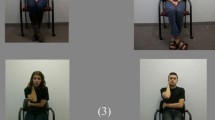ABSTRACT:
The Test of Nonverbal Cue Knowledge (TONCK), a paper and pencil test measuring explicit knowledge of nonverbal cue meanings and uses, was developed and found to be reliable and to have predictive ability. In four studies, participants were given the TONCK and one or more tests of accuracy in decoding nonverbal cues the adult faces and voices tests of the Diagnostic Analysis of Nonverbal Accuracy 2 (DANVA) and the video and audio tests of the Profile of Nonverbal Sensitivity (PONS), as well as a test of general cognitive ability (the Wonderlic Personnel Test). Results are reported for the four studies individually and also in a meta-analytic summary. Females scored higher than males on the TONCK and on the PONS, and the TONCK predicted accuracy on the PONS and DANVA. Knowledge of nonverbal cues did not account for the gender difference in decoding ability on the PONS. Cognitive ability was related to the TONCK but did not compromise relations with other variables. The future utility of the TONCK, content specificity of tests, as well as the automaticity of judging cues are discussed.
Similar content being viewed by others
Author information
Authors and Affiliations
Corresponding author
Additional information
The authors thank Crystal Mileti, Jenna Lavery, Erica Dempsey, and Jared Majerle for their assistance in conducting this research.
Rights and permissions
About this article
Cite this article
Rosip, J.C., Hall, J.A. KNOWLEDGE OF NONVERBAL CUES, GENDER, AND NONVERBAL DECODING ACCURACY. J Nonverbal Behav 28, 267–286 (2004). https://doi.org/10.1007/s10919-004-4159-6
Issue Date:
DOI: https://doi.org/10.1007/s10919-004-4159-6




